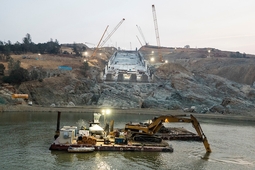-This is a caption display style to be used for describing various media items including photos and videos.
SACRAMENTO – The Department of Water Resources (DWR) today released the operations plan for Lake Oroville during the 2017-18 rainy season to protect public safety while construction continues on the reservoir’s main and emergency spillways.
The plan, which will guide reservoir operations between November 1 and April 2018, calls for DWR to maintain lower-than-average lake levels during the winter months to provide space for inflows and manage releases from the substantially reconstructed main spillway.
“This plan puts public safety first, while also meeting our water supply and environmental obligations as we repair and rebuild the Lake Oroville spillways,” said DWR Director Grant Davis. “We will operate Lake Oroville conservatively until construction on both spillways is complete in late 2018, early 2019.”
The plan calls for DWR to lower the lake level to an elevation of 700 feet by November 1, compared to the average 780 feet elevation maintained on that date in prior years. The lower level will provide more than 2.2 million acre-feet of flood reserve storage to accommodate inflows during the rainy season. The lower lake level, combined with operational contingencies, should allow DWR to keep releases from the mostly reconstructed main spillway at 100,000 cubic-feet per second (cfs) or less over the winter and ensure lake levels remain below 901 feet, the level that would require use of the emergency spillway, which is still undergoing construction.
Work to repair and reconstruct the main spillway has been underway since April. By November 1, the main spillway will be prepared to handle releases of up to 100,000 cfs. By next season, it will be fully reconstructed to handle the original design capacity of 270,000 cfs. Releases from the main spillway have never been above 160,000 cfs.
In the event the reservoir rises quickly during the winter months, the operations plan identifies certain elevations at which DWR will increase outflows through the Hyatt Powerplant, the river valve outlets or the main spillway to safely manage lake levels.
DWR consulted with the United States Army Corps of Engineers during development of the plan and has shared it with the Federal Energy Regulatory Commission and California’s Division of Safety of Dams for additional input. During this consultation, DWR shared data showing that Lake Oroville operations would be able to manage storm events such as those in 1997 and 2017 without flows greater than 100,000 cfs over the main spillway and without using the emergency spillway.
DWR will assess the operations plan for the remainder of the year in April, when hydrologic and snowpack conditions are clearer, to guide operations through the completion of construction on Lake Oroville’s main and emergency spillways. After construction is complete in early 2019, DWR, in consultation with the USACE, plans to begin working on a long-term operations plan, which will involve extensive public engagement.
###
For more information, follow us on Twitter or Facebook, read our news releases or visit our Oroville Spillway Incident webpage.
